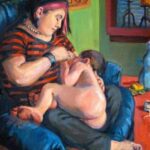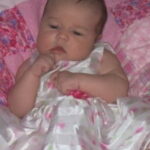When my twins were born a month early, they were a bit premature to properly latch on when I attempted to breastfeed them. During my hospital stay, we tried syringe feeding, one at a time, multiple positions, but my babies could not pick up on the concept. When almost all hope was gone, my lactation consultant brought in a Medela Nipple Shield, which was the answer to my prayers. Both babies immediately latched on and for the first time since they were born, I successively breastfed my twins.
For those who don’t know what a nipple shield is, it is merely an extension of a woman’s natural nipple- usually made of sylicone or plastic. I stuck with Medela because it is BPA-free. A baby who is premature has an easier time drinking milk as this device helps a baby draw milk from the breast. The downsides of a nipple shield is that it doesn’t properly compress the milk ducts fully, which can lead to a decrease in milk supply. When I started using the nipple shield, the lactation consultant said I needed to be rid of it within two weeks, as the twin’s pediatrician also stressed at their one week wellness visit.
However, after two weeks, my boys still could just not latch on. I was overly stressed because I was afraid my milk supply would go down and I put undo stress on my twins. They would attempt to latch, get frustrated after a minute, and refuse to eat, which was not good since they were preemies and trying to gain weight. After two weeks, I decided to look for help. La Leche League was no help so I turned to the Mothers of Multiples Club for answers. After many Moms told me they were never offered the shield and many were unable to nurse, I finally was paired with someone who was still using the nipple shield on her twins at five months and had no problems with her supply or her twins developing properly.
This was a huge relief to hear since any information I could find online made nipple shields out to be very negative, but none was actually pertaining to personal experience. What was surprising is many lactation consultants in my area didn’t have experience dealing with nipple shields so I had to find someone on my own to converse with about the use of nipple shields. When speaking with her last month, her twins were going on nine months old and still using the nipple shield as they had never learned to properly latch on. I tried every now and then to get mine to eat without it, but since my milk supply was not in any danger, I didn’t want to put any stress on them.
A week ago, my boys took the nipple shield off on their own accord and latched on to eat properly. Within two days, both were having no problems latching or eating. They just turned five months old yesterday and I am excited. Their nursing now takes a lot less time than it used to, I am no longer concerned about my milk supply ever being depleted, and they have no nipple confusion (another con with using the nipple shield). I wanted to tell my story so if there is another mother out there using the nipple shield with no success breastfeeding without one, that it is okay. I would have loved to have had some positive information those first two weeks as it would have made my breastfeeding experience a lot more enjoyable with much less stress. But if you are using a shield or know someone using a shield, do know your baby might eventually latch on without the shield. Most importantly, nipple shields are not evil and using them does not mean your nursing days are guaranteed not to last very long- just look forward to your nursing experience and bonding with or baby (or babies).


